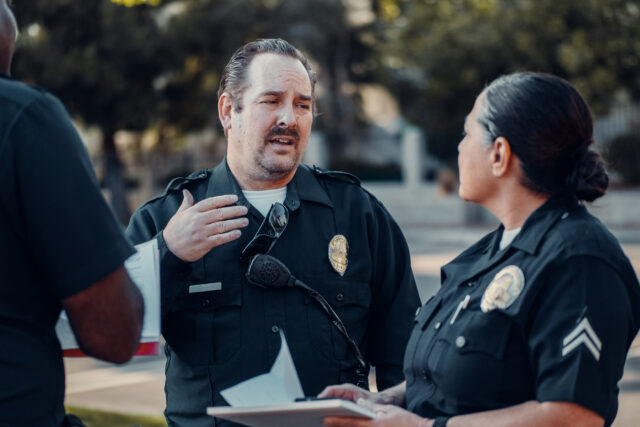Around California and the nation, debate has intensified over how lawmakers can address stark racial disparities in police interactions and build policies that safely reduce use of force. Two PPIC reports probe available data to understand the extent of racial disparities in law enforcement stops and police use of force and misconduct in California. At a recent event, PPIC researchers Magnus Lofstrom and Deepak Premkumar presented takeaways from these reports, exploring how context and other factors shape experiences.
Under the Racial and Identity Profiling Act (RIPA) law enforcement agencies must collect information on all pedestrian and vehicle stops; officers report perceived personal characteristics of individuals, the reason for the stop, jurisdiction, and agency. PPIC researchers examined nearly 4 million stops made in 2019 by California Highway Patrol, eight police departments, and six sheriff’s departments to understand how individual experiences differ, especially for white and Black Californians.
About 20% of all stops of Black Californians led to a search; the rate was 8% for white Californians. Yet searches of Black individuals were less likely to yield evidence. Stops of Black Californians were less likely to lead to enforcement but more likely to be intrusive. Gaps notably narrow when adjusted for factors such as age and gender, jurisdiction, and context (a traffic violation vs. reasonable suspicion or an arrest warrant), but disparities still remained.
“This type of data-driven research can inform discussions and efforts to reduce racial disparities in policing,” Lofstrom said. “It shows support for the concerns historically voiced by communities of color about inequities. It also shows that some of those disparities may be driven by officer challenges and responsibilities in a stop.”
To quantify police use of force in California and context around incidents, Premkumar examined several publicly available data sources against data collected for Assembly Bill 71. AB 71 mandates that agencies report details on all serious use of force incidents and firearm discharges, regardless of whether an officer is on duty. For misconduct, Premkumar turned to the Stinson database created by an ex-police officer, as no state data is yet available.
About 80 officers are arrested annually for misconduct—or about 0.1% of all California officers; sexual or violent assault is the most common reason for an arrest. Premkumar noted that misconduct differs from use of force: most use of force has legal and procedural justifications.
Each year in California, almost 200 civilians die in police encounters involving use of force. For all deaths and gunshot injuries, about 80% of civilians are armed. Among serious injuries, that number drops to about 44%. “Or put differently,” Premkumar said, “56% of those in serious use-of-force incidents involve an unarmed civilian; these are the ones that are likely to generate public scrutiny and potentially damage trust in law enforcement.”
Identifying the initial reason for a police response provides important context for serious use-of-force incidents—primarily, police are responding to calls for service: a 911 call or a call to a police department. The next most common contact is for a crime in progress. In both situations, officers may perceive a higher level of threat. However, 15% of incidents begin as a traffic stop. Furthermore, over four in ten incidents involve a civilian with a behavioral health condition, often substance use or a mental health issue.
California is seeking solutions. A few municipalities are working to reduce traffic stops or even shift away from non-police agencies to handle traffic violations. As an alternative for mental health emergencies, the California Legislature proposed a bill to provide pilot grants to community-based organizations for managing response services. “As California passes additional legislation,” Premkumar said, “it will be important to evaluate reforms on their effect on police use of force, public safety, and racial disparities.”
Topics
Criminal Justice police Racial and Identity Profiling Act racial disparitiesLearn More

Arrests in California

Law Enforcement Staffing in California

Historic Law Aims to Improve Police Accountability and Transparency

New Law Raises Standards for Police Officers

Police Use of Force and Misconduct in California



